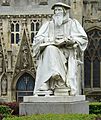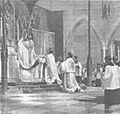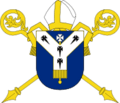Anglicanism facts for kids
Anglicanism is a Christian group or denomination. It includes the Church of England and the Anglican Communion. The Anglican Communion is a worldwide family of Anglican churches.
Anglicanism began during the English Reformation. This was a time when the English Church changed many things. The biggest change was rejecting the Pope and the Catholic Church as an organization.
Some people see Anglicanism as a middle path. It is often seen as being between Roman Catholicism and Protestantism. This is why it is not always called Protestantism.
The word Anglican comes from the Latin phrase ecclesia anglicana. This phrase means 'the English Church'. It was used as early as 1246. The word Anglican describes the people, churches, and ideas connected to the Church of England. It also describes the Anglican Communion. This is a group of thirty-eight church provinces around the world. They are all connected to the Archbishop of Canterbury.
Contents
How Anglicans Worship
Anglicans have many different beliefs. For example, there are different ideas about Holy Communion. This is a special meal where Christians remember Jesus.
Some Anglicans believe the bread and wine truly become the Body and Blood of Christ. This view is called 'High Church' and is less common. It is similar to beliefs in Roman Catholicism and Orthodoxy.
Other Anglicans believe Holy Communion is a way to remember Jesus' life and death. This view is called 'Low Church' and is more common. It is similar to the beliefs of most Protestants. Anglicanism is mainly a Protestant church. This is because the Bible is its main authority, not the Pope.
Where Anglicanism Started
The name Anglican comes from the Latin word for English. This is because the Church began in England. In the British Isles, Anglicanism was once the official religion in many places.
Church leaders and the government worked together. This was called the alliance of Throne and Altar, or Church and State. They wanted the Anglican Church to welcome many different Christian believers. They hoped this would encourage many citizens to worship in the official church.
How it Began in Britain
King Henry VIII wanted to divorce his wife, Catherine of Aragon. The Pope would not let him. So, King Henry decided to break away from the Roman Catholic Church. He then started the Church of England.
The English Parliament passed the Act of Supremacy. This act said King Henry VIII was the "Supreme Head of the Church of England." This meant the king, not the pope, was the head of the Church in England. This act allowed Henry VIII to divorce and remarry. It also made England free from the Pope's influence.
At first, the English Church kept many Roman Catholic beliefs. But over time, the Church of England changed more. This period is known as the English Reformation. These changes helped form the modern Anglican Communion.
Today, Anglicanism is still the official religion only in England. The monarch, Queen Elizabeth II, is the Supreme Governor on Earth of the Church of England. The Archbishop of Canterbury leads the Church. The General Synod is its legal Parliament.
How Anglicanism Spread
Anglicanism spread around the world in other ways. It grew through overseas colonization, settlement, and missionary work. In most countries, Anglicanism is a regular Christian denomination. It does not have special status.
Anglicans worldwide are part of the Anglican Communion. This is a group of national churches. Today, there are over 80 million Anglicans. Most of them live in Africa and Asia. Many are not of British background anymore.
Current Issues
The Anglican Communion faces challenges today. It is discussing the role of women and gay people in the Church. As these issues are discussed, some groups have split. Some Anglicans have formed their own separate churches. They sometimes use names like Anglican Catholic or Anglican Reformed.
At the same time, Anglican leaders talk with the Roman Catholic and Orthodox Churches. They hope to work towards Christian unity. There has been some progress. Also, the Anglican and Lutheran Churches have agreed to share beliefs and practices. This is called intercommunion.
Related pages
- History
- Movements and denominations
- Prominent Anglican Thinkers
- Hein, David, ed. (1991) Readings in Anglican Spirituality. Cincinnati: Forward Movement.
Images for kids
-
Jesus Christ supporting an English flag and staff in the crook of his right arm depicted in a stained glass window in Rochester Cathedral, Kent
-
Saint Alban is venerated as the first-recorded British Christian martyr.
-
Augustine of Canterbury was the first Archbishop of Canterbury.
-
Queen Elizabeth I revived the Church of England in 1559, and established a uniform faith and practice. She took the title "Supreme Governor".
-
Frederick Denison Maurice was a prominent 19th-century Anglican theologian
-
Richard Hooker (1554–1600), one of the most influential figures in shaping Anglican theology and self-identity.
-
Thomas Cranmer wrote the first two editions of the Book of Common Prayer, BCP
-
An eastward-facing Solemn High Mass, a Catholic liturgical phenomenon which re-emerged in Anglicanism following the Catholic Revival of the 19th century
-
The 1596 Book of Common Prayer
-
Evensong at York Minster
-
1854 image of the ruins of Jamestown Church, the first Anglican church in North America
-
High altar at the Anglo-Catholic Church of the Good Shepherd (Rosemont, Pennsylvania)
-
Christ Church Cathedral in Dublin
-
Justin Welby in South Korea. As the Archbishop of Canterbury, Welby is the symbolic head of the international Anglican Communion.
See also
 In Spanish: Anglicanismo para niños
In Spanish: Anglicanismo para niños



















